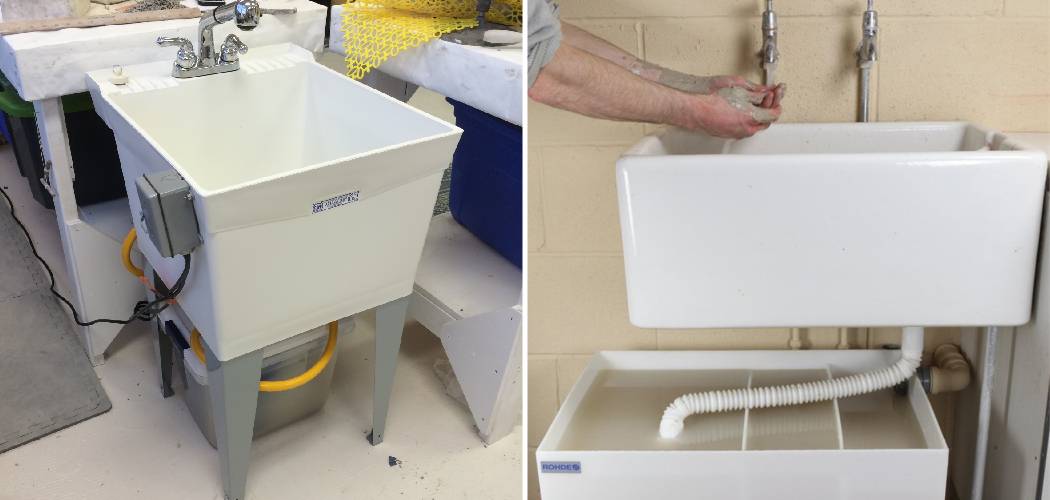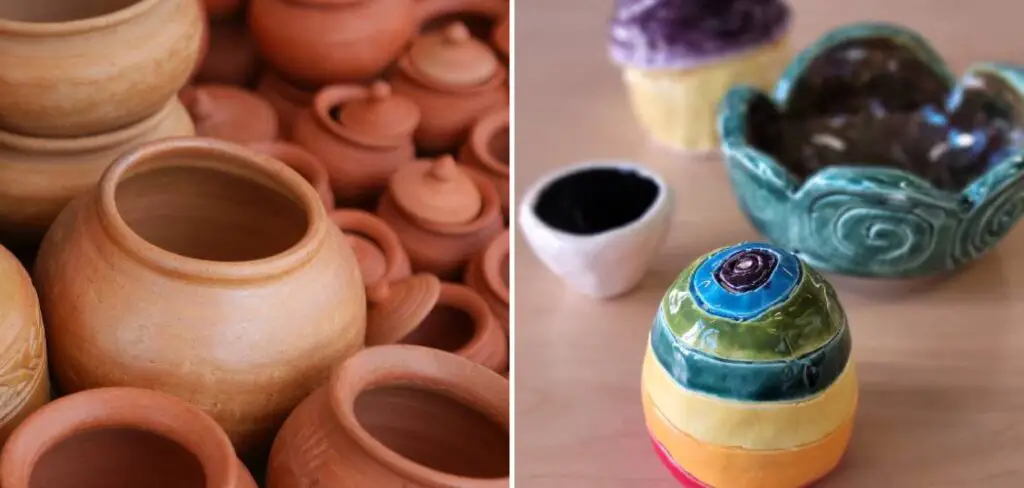Finding the best kilns for home use is an exciting journey for artists, craftsmen, and hobbyists looking to explore the world of ceramics, pottery, and glass fusing. Kilns are vital in firing and transforming raw materials into beautifully crafted art pieces.
Whether a beginner or an experienced artist, investing in a reliable and efficient kiln can greatly enhance your creative endeavours, however, choosing the right one can be daunting with the wide range of kilns available.
Factors such as size, temperature range, energy efficiency, and ease of use come into play when selecting the perfect kiln for your home studio. In this article, we will explore some of the best kilns for home use, highlighting their features and benefits to help you make an informed decision and unlock your artistic potential.
Table of Contents
5 Best Kilns for Home Use
1. Melting Furnace RapidFire Tabletop Kiln
Introducing the Melting Furnace RapidFire Tabletop Kiln. Are you a professional artist constantly on the move? If so, this kiln is sure to become your go-to MacGuffin! Want to take your art projects wherever life takes you? The tiny but powerful RapidFire Pro-L Kiln offers an efficient and cost-effective solution for the most valued customers – professional artists!
This incredibly compact kiln lets you take it wherever the creative sparks fly easily. It effectively melts glass, precious metals, and other materials in less than half the time of comparable products without compromising the quality of your work. And don’t let its convenient size fool you – this highly durable unit can operate continuously for up to 20 hours or more until it needs cool down, providing you with plenty of time for all your projects!
The Melting Furnace RapidFire Tabletop Kiln is fast and efficient, getting your melting projects up and running in 8 to 10 minutes! Achieving temperatures up to 2200°F (1200°C), this tabletop kiln takes your metalworking, glass fusing, and ceramic projects to a new level.
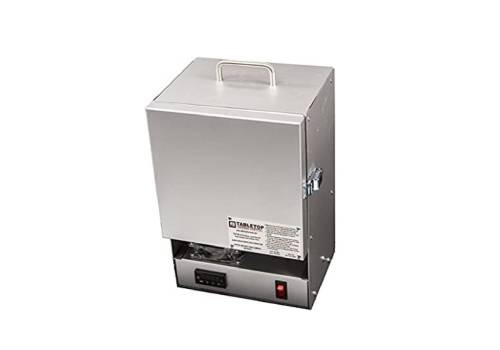
Pros:
- Compact and portable design
- Highly durable construction
- Digital temperature settings for accurate control
- Fast heating elements reach temperatures up to 2200°F (1200°C)
- 15-amp circuit breaker prevents overload
Cons:
- Does not come with a kiln shelf or stand
2. Tabletop Hi-Temp 2200 Degree Electric Burnout Oven Kiln
The Tabletop Hi-Temp 2200 Degree Electric Burnout Oven Kiln is ideal for those looking to achieve professional quality results with a more affordable size and cost than industrial ovens. This electric kiln reaches an impressive maximum working temperature of 2200°F, giving you the power to tackle large projects with ease.
The oven kiln is also designed with a PROGRAMMABLE controller that gives you precise control over your firing time and temperature. This allows for repeatable results, making producing consistent work at any level easier.
For those seeking a smaller but reliable option, the Tabletop Hi-Temp 2200 Degree Electric Burnout Kiln offers great value at an excellent price. Whether you’re an experienced craftsman or just getting started in the world of ceramics, this oven kiln provides exceptional performance at an affordable cost.
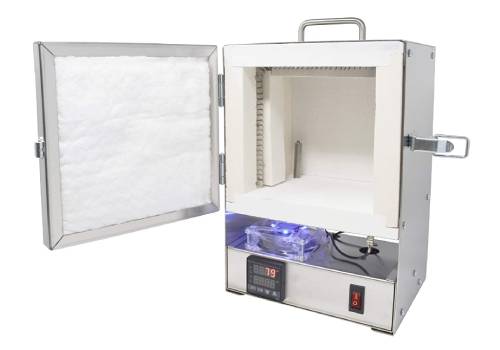
Pros:
- Programmable temperature control for precise results
- Reach temperatures up to 2200°F
- Compact size and lightweight design for easy movement
- Affordable price for the level of performance
Cons:
- Not suitable for large-scale projects
- Limited accessories included with the oven kiln
3. Melting Furnace RapidFire Programmable Tabletop Kiln
The Melting Furnace RapidFire Programmable Tabletop Kiln is the perfect tool for professional artists looking to take their projects to the next level. Kiln offers an amazing portability, functionality, and performance combination that other comparable products can’t match. The RapidFire Pro-LP Kiln provides precise control over your creative process and does so at a price point that won’t break the bank.
With its robust and reliable construction and straightforward operation, this Kiln will become your go-to for all your projects. You can be confident in knowing that no matter what project you have in mind, Melting Furnace RapidFire Kiln will provide the support required to bring it to fruition.
Thanks to its easy-to-use programming options, you can easily customize firing cycles for almost any type of project. This high-quality kiln has multiple safety features, such as automatic shutoff after a set time and temperature, that help ensure all your projects turn out perfectly. And since it’s lightweight, portable, and easy to set up and break down quickly, you can take the Melting Furnace anywhere you need it!
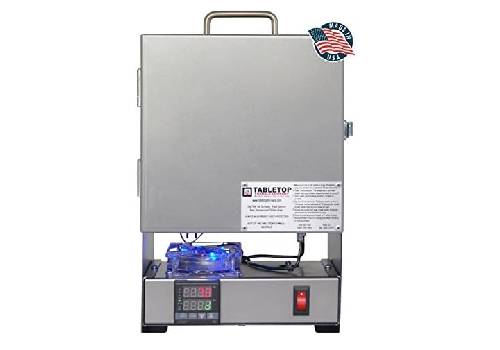
Pros:
- Precise control over firing cycles and temperatures
- Robust construction and easy operation
- Multiple safety features for reliable use
- Lightweight and portable for easy transportation
- Affordable price point
Cons:
- Not durable for extended use
4. RapidFire Pro-LP Electric Kiln Furnace
Discover the ultimate portability, function, and performance combination with the RapidFire Pro-LP Electric Kiln Furnace! This all-in-one kiln furnace is perfect for professional artists and hobbyists alike and offers everything you need to create stunning artwork with clay, metal, and other materials. A compact design makes it an ideal choice when travelling or working in a smaller space.
The precision temperature control allows you to adjust temperatures with ease and flexibility while you work, so you can achieve perfect results on any project you have in mind. You’ll appreciate the durable construction that ensures reliable operation over time and the surprisingly low cost for such a high-performing product. With its easy setup and intuitive controls, the RapidFire Pro-LP is your go-to kiln for creating professional results every time!
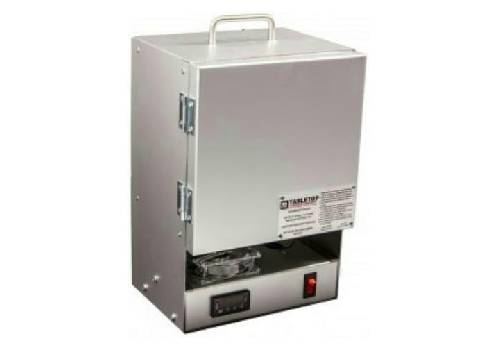
Pros:
- The portable and compact design makes it easy to move around
- Precision temperature control for greater accuracy
- Durable construction ensures reliable operation
- Low cost for an impressive performance
Cons:
- Limited capacity may be a problem for larger projects.
5. Tabletop QuikMelt 120oz PRO
Introducing the industry’s most powerful tabletop melting furnace: QuikMelt 120oz PRO. Perfect for any professional smelting operation, the QuikMelt 120oz PRO is guaranteed to complete the job quickly and efficiently. Its powerful heating element reaches temperatures up to 1,900°F and is designed to melt up to 120 troy ounces of gold in 8-10 minutes, saving considerable time and effort.
With its advanced temperature control panel, you’ll have plenty of precise settings at your fingertips, helping you get the most out of each session. Other stand-out features include a safety lock valve that releases pressure should it reach dangerous levels; highly resistant stainless steel construction to withstand extreme temperatures.
The QuikMelt is a high-powered, reliable, industrial-grade melting cube for all materials. It features an impressive 2,200°F maximum temperature—equipping it to melt quickly and efficiently gold, silver, lead, copper, zinc, precious metal clay, ceramics, and special alloys, all without risk of overheating or warping. Plus, it utilizes 120 Volt power, so you can rest assured that your projects will be completed easily and precisely every time!
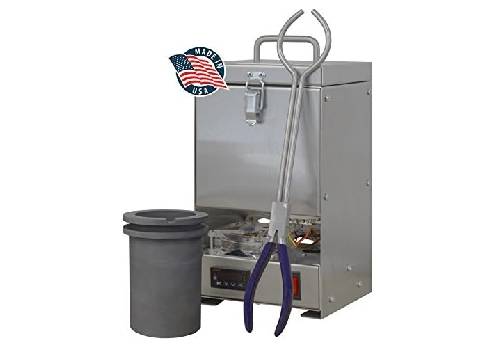
Pros:
- Powerful heating element – reaches temperatures up to 1,900°F
- Melt up to 120 troy ounces of gold in 8-10 minutes
- Advanced temperature control panel for precise settings
- Safety lock valve to release pressure if it reaches dangerous levels
- Highly resistant stainless steel construction to withstand extreme temperatures
- 2,200°F maximum temperature to melt gold, silver, lead, copper, zinc, and other alloys
- 120 Volt power for easy operation
Cons:
- Due to its advanced features, the QuikMelt 120oz PRO is on the expensive side
- At 19” x 13” x 15”, it is quite bulky and not suitable for smaller workspaces
- Requires special ventilation to ensure safe operation
Introduction to Kilns: Understanding the Basics
A kiln is a furnace fires ceramics, pottery, and other materials at high temperatures. The history of kilns dates back to ancient times when they were used for making pottery and smelting metals. Today, kilns are used in various industries, including art, science, and manufacturing.
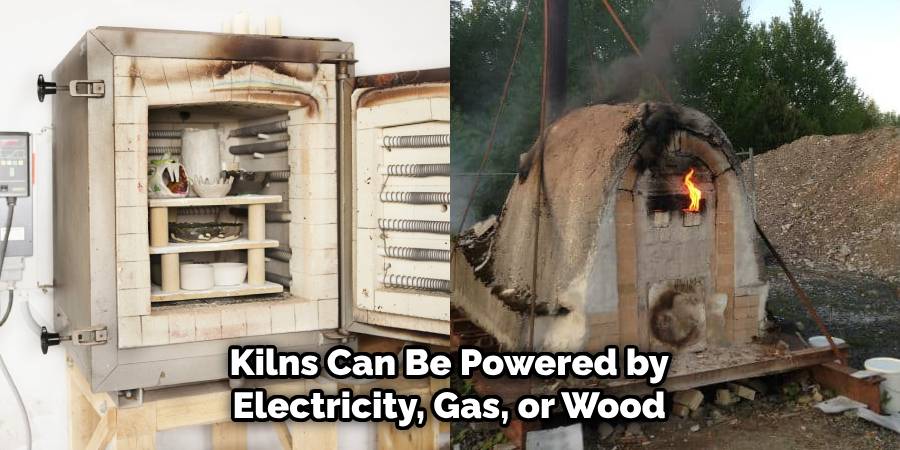
The basic components of a kiln include the heating element, insulation, and a control system for regulating temperature and airflow. Kilns can be powered by electricity, gas, or wood and come in various sizes and shapes to accommodate different needs.
Kilns have been a fundamental tool for artisans and craftsmen for centuries, enabling the transformation of raw materials into durable and captivating creations. These versatile heating chambers are used in various industries, including ceramics, pottery, glassmaking, and metalworking. Understanding the basics of kilns is essential for anyone interested in these artistic pursuits or those seeking to explore the fascinating world of firing and shaping materials.
Types of Kilns: Which One is Right for You?
There are three main types of kilns: electric, gas, and wood-fired. Electric kilns are the most common type used in home studios due to their ease of use and affordability. Some artists prefer gas kilns for their ability to produce unique effects on the finished product. Wood-fired kilns are less common but are favoured by some artists for their traditional and rustic aesthetic.
The type of work you will do is an important factor when choosing a kiln. If you will be working with large pieces, you will need a kiln with a larger capacity. If you do intricate work, you may need a kiln that allows for precise temperature control. Additionally, the amount of space you have available is also important.
If you have limited space, you may need to choose a smaller kiln or one that can be easily moved. Your budget is also crucial in choosing the best kilns for home use. Kilns can range in price from a few hundred dollars to several thousand dollars, so it is important to set a budget and stick to it. Choosing the right kiln requires careful consideration of your specific needs and circumstances.
Factors to Consider When Choosing a Kiln for Your Home Studio
When selecting a kiln for your home studio, it is important to consider the specific purpose for which you will be using it. Pottery kilns are designed to reach high temperatures and maintain them for extended periods, while glass fusing kilns are typically smaller and require less heat.
Other types of kilns may be used for jewellery making, metal clay firing, or other specialized projects. Once you have determined the type of kiln you need, consider the space in your studio. Kilns come in various sizes, from small tabletop models to larger floor-standing units. You will also need to consider the power source you will be using.
Electric kilns are the most common type for home studios, but gas-fired and wood-fired kilns are also available. Finally, consider your budget and any other special features or considerations that may be important to you. Some kilns come with programmable controllers, ventilation systems, or other features that may be useful depending on your specific needs.
Size Matters: Determining the Right Kiln Size for Your Needs
Additionally, it is important to consider how much work you will be doing and how often you will be firing pieces. If you plan on firing frequently or in large quantities, a larger kiln may be necessary to accommodate your workload.
On the other hand, if you only plan on firing occasionally or for personal use, a smaller kiln may suffice. It is also important to consider the space available for the kiln, as larger models may require more room and ventilation. Choosing the right kiln size is crucial for achieving successful firings and producing high-quality ceramic pieces.
Electric VS Gas Kilns: Pros and Cons
Electric kilns are popular among artists and potters due to their ease of use and low maintenance requirements. They are also known for their consistent heating, ensuring the temperature remains constant throughout the firing process. However, electric kilns can be more expensive than gas kilns, as they require significant electricity to function.
On the other hand, gas kilns are preferred by some artists for their ability to produce unique effects on the finished product. The combustion process in a gas kiln can create a range of colours and textures on the surface of the clay, which can add depth and complexity to the final piece.
However, gas kilns can be more difficult to operate than electric kilns, as they require careful monitoring of the fuel supply and ventilation system. In addition, gas kilns require more maintenance than electric kilns. The burners and fuel lines must be regularly inspected to ensure they function properly.
Gas kilns also produce exhaust fumes that must be vented outside, which can require additional equipment and installation costs. The choice between an electric or gas kiln depends on the artist’s preferences and needs. Electric kilns are ideal for those prioritizing ease of use and low maintenance. In contrast, gas kilns are better suited for those who want to experiment with unique firing effects and are willing to invest more time and effort into maintenance.
Kiln Features to Look for: Temperature Control, Ventilation, and More
When selecting a kiln, it is important to consider your work’s specific requirements. For instance, if you are working with ceramics, you will need a kiln that can reach high temperatures and maintain them consistently.
On the other hand, if you are working with glass, you will need a kiln that can heat up quickly and cool down slowly to prevent cracking. Ventilation options are also important, especially if you work with materials that produce fumes or gases when heated. Some kilns come with built-in ventilation systems, while others require external ventilation.
Additionally, some kilns offer programmable temperature controls, allowing you to set specific heating and cooling cycles for your work. Other features to consider include the size of the kiln, the type of heating element used (e.g. gas or electric), and the overall durability and reliability of the kiln. By carefully considering these factors, you can choose a kiln that meets your needs and helps you achieve your desired results.
Budgeting for a Kiln: How Much Should You Expect to Spend?
In addition to the kiln’s type, size, and features, other factors can affect the cost. For example, the brand and quality of the kiln can also impact the price. Some brands are known for their durability and reliability, which can make them more expensive.
Additionally, if you need to have the kiln installed or shipped, additional costs may be associated with those services. Researching and comparing prices from different suppliers is important to ensure you get the best value for your money.
Remember that investing in a high-quality kiln can pay off in the long run by allowing you to produce higher-quality work and increase productivity. However, budget-friendly options are also available for those on a tighter budget.
In summary, selecting the right kiln for your home studio requires carefully considering your needs. Consider the type of work you will be doing, the size and power source of the kiln, and any special features or considerations. Additionally, factor in your budget to find a kiln that meets all your requirements without breaking the bank. Doing so can ensure you invest in your studio’s best kiln.
Kiln Maintenance: Tips for Keeping Your Kiln in Top Shape
Kiln maintenance regularly is essential for longevity and proper functioning. By performing routine tasks such as cleaning, you can prevent the buildup of debris and dust that can clog the ventilation system and cause overheating.
Replacing heating elements is crucial as they can wear out over time and become less effective, resulting in longer firing times and uneven heating. Checking for leaks is another important task, as it can prevent dangerous gas leaks that can lead to fires or explosions.
By keeping up with regular maintenance, you can ensure that your kiln operates safely and efficiently, providing you with consistent and high-quality results every time. Additionally, regular maintenance can save you money in the long run by preventing costly repairs or replacements due to neglect or damage caused by lack of maintenance.
Kiln Safety: Precautions to Take When Operating a Kiln at Home
Operating a kiln at home can be a fun and rewarding experience. Still, it is important to remember that it can also be dangerous if proper safety precautions are not taken. One of the most important things to do before using a kiln is to read and follow all manufacturer instructions and guidelines carefully.
This will help ensure that you are using the kiln safely and effectively. In addition to following manufacturer instructions, taking other precautions when using a kiln is important. For example, it is recommended that you wear protective gear such as gloves, goggles, and a respirator mask to protect yourself from exposure to high temperatures, toxic fumes, and other hazards.
It is also important to ensure that your workspace is properly ventilated, as this can help reduce the risk of exposure to harmful fumes. Some common safety hazards associated with operating a kiln include fire, electrical shock, and exposure to toxic fumes. To reduce the risk of fire, it is important to keep flammable materials away from the kiln and to ensure that the kiln is properly maintained and cleaned.
To reduce the risk of electrical shock, it is important to use a grounded outlet and to avoid touching any electrical components while the kiln is in use. And to reduce the risk of exposure to toxic fumes, it is important to ensure that your workspace is properly ventilated and that you wear appropriate protective gear.
In summary, operating a kiln at home can be a fun and rewarding experience. Still, it is important to take proper safety precautions to ensure you use the kiln safely and effectively. By following manufacturer instructions, wearing protective gear, ensuring proper ventilation, and being aware of common safety hazards, you can help reduce the risk of injury or harm while using your kiln.
Some Common Mistakes to Avoid When Choosing Kiln for Home Use
When it comes to choosing the best kilns for home use, there are some common mistakes that you should avoid. One of the most common mistakes is underestimating the size and power of the kiln required for your specific project. If you choose a too-small kiln, you may have difficulty accommodating all of your pieces or projects. On the other hand, choosing a kiln that is too powerful might lead to an over-fired or under-fired product. It’s important to consider your intended use and select the correct size and power for your project.
Another mistake to avoid when selecting a home kiln is neglecting safety features. Although most pottery kilns are designed with built-in safety features, some may not be up to standards or may lack necessary components such as venting systems and temperature controls. Ensuring your kiln has all the necessary safety elements can help protect you and your equipment from damage or injury while working in hot conditions.
Finally, another common mistake people make when choosing a home kiln is not considering all the accessories needed for their project. Although most kilns will come with some essential tools such as thermometers, shelves, and stilts, it’s important to think about additional items that may be necessary. For instance, you might need specialized tools like electronic controllers or larger shelves for bigger projects. Consider all the accessories you might need for your project before buying your kiln.
By avoiding these common mistakes, you can ensure that you purchase a quality kiln that is the perfect size and power for your project needs. Researching and understanding your specific requirements can help you make an informed decision when selecting a kiln for home use.
Conclusion:
When choosing a kiln for your home studio, it is important to consider the type of work you will be doing. If you plan on working with larger pieces, you may need a kiln with a larger capacity. Additionally, if you plan on firing different types of clay or glazes, you may need a kiln with different temperature settings.
It is also important to consider the amount of space you have available in your studio. If you have limited space, you may need to choose a smaller kiln or consider a kiln that can be stacked. Your budget is also an important factor to consider when choosing a kiln.
Kilns can range in price from a few hundred dollars to several thousand dollars, so choosing one that fits your budget is important. Finally, it is crucial to prioritize safety and maintenance when operating your kiln. Always follow the manufacturer’s instructions and guidelines for safe operation and maintenance to ensure your kiln operates safely and efficiently. So, there you have it – a quick and easy guide on the best kilns for home use.
